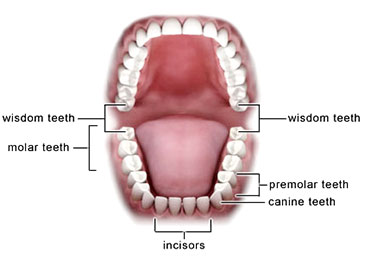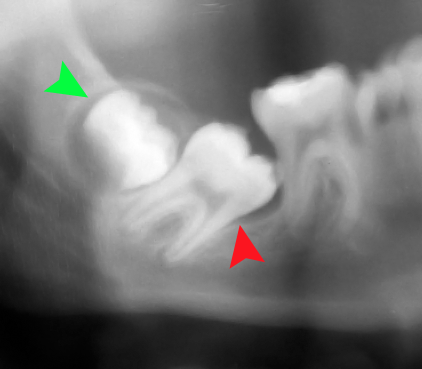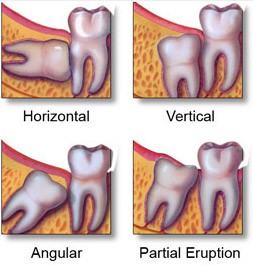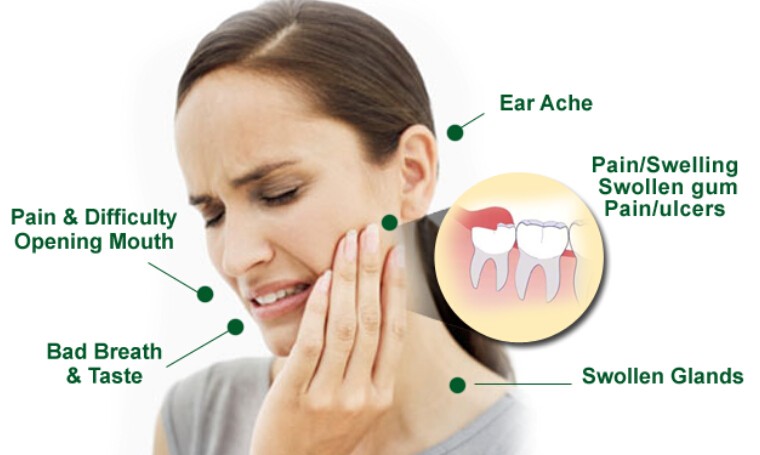In general, the cost of removing a wisdom tooth can range anywhere from $100 to $600 per tooth which generally covers local anesthesia and follow-up visits with your dentist. The cost can vary tremendously as there are a number of factors that can affect it. We will explore these in this guide.
| Wisdom Teeth Extraction Cost | |
|---|---|
| Simple Non-Surgical Extraction | $100 to $200 |
| Soft Tissue Impaction | $200 to $400 |
| Partial Bony Impaction | $275 to $450 |
| Full Bony Impaction | $325 to $600 |
- Cost of a Simple Wisdom Tooth Extraction
- Impacted Wisdom Tooth Removal Cost
- Cost to Remove All 4 Teeth
- Additional Fees
- Factors That Affect the Cost
- Financing the Cost of the Procedure
- Factors That Can Affect the Complexity of the Procedure
- Why do Wisdom Teeth Cause Problems?
- When is it Necessary to Remove Wisdom Teeth?
- Procedure Overview
- Choosing Your Dentist or Oral Surgeon
Simple Wisdom Tooth Extraction Cost

The cost of an extraction using local anesthetic is around $100 to $200 per tooth. Your dentist may charge between $300 and $800 to have all four wisdom teeth removed.
Impacted Wisdom Tooth Removal Cost
 An impacted wisdom tooth removal is more complicated, depending on whether it is partially erupted or is fully encased in your jawbone. The least expensive impacted tooth removals are those that are partially erupted through the gums, while the most expensive are beneath the gums and encased in bone.
An impacted wisdom tooth removal is more complicated, depending on whether it is partially erupted or is fully encased in your jawbone. The least expensive impacted tooth removals are those that are partially erupted through the gums, while the most expensive are beneath the gums and encased in bone.
An impacted tooth can cost between $275 and $600 to remove. Using sedation dentistry such as nitrous oxide typically adds another $50 to $100 to the price. If general anesthesia is needed, this can add another $250 to $800 to the total cost.
Cost to Remove All 4 Teeth
It’s quite common for dentists and oral surgeons to offer a package deal for removing all four wisdom teeth at once. The cost for removing all four, plus sedation can range from $1100 to $1700 in regions with a lower cost of living.
The average cost nationwide for removing four wisdom teeth under general anesthesia is between $1400 and $2200. The most complicated wisdom tooth removals in high-cost regions can range from $2400 to $3000. An oral surgeon’s fees are typically higher compared to general dentists.
Additional Fees
Various diagnostic tests are required to determine the position of the tooth, the shape of the tooth’s root and the position of surrounding structures such as nerves and blood vessels.
In most cases, a panoramic x-ray will be required before the tooth is extracted and this can cost between $60 and $150. If a cone beam CT scan is needed, you may be charged anywhere between $250 and $600. An initial examination will cost between $50 and $300.
When you visit your dentist to inquire, it’s worth asking for a breakdown of all the costs included in the quoted price.
Factors That Affect the Cost
Your dentist will base their fee on the time required and the anticipated difficulty of the extraction. The degree of difficulty will depend on the position of the tooth in your jaw and whether it is partially erupted, fully erupted, or fully enclosed in the jawbone. Other factors influencing the cost of your wisdom tooth extraction include:
- Diagnostic tests such as x-rays and cone beam CT scans
- The location of your dentist, as some cities are more expensive than others
- The experience and specialty of your dentist, and even their popularity
- Whether the cost is covered by your dental insurance or discount plan
With and Without Insurance Coverage
Dental insurance coverage for tooth extractions can vary considerably. Your policy may cover from 15% to 50% if the procedure is deemed to be medically necessary. It also depends on whether your dental plan has an annual maximum, as some will only pay between $1000 and $1500 each year.
Without insurance coverage, the cost of extracting a single impacted tooth ranges from $250 to $750. Out-of-pocket costs for those with coverage can range from $125 to $600. Coverage can vary tremendously, according to your insurer and your policy so it’s worth doing the research ahead of time.
People without dental insurance pay from $800 to $2,750 (average of $1,700) to have all four teeth removed at the same time. Those with dental insurance have out-of-pocket expenses of $200 to $1000 (average of $700) for removing all four.
Saving Money
It is worth inquiring at any nearby dental school clinics as they provide treatments at reduced rates. They offer services provided by recently graduated dental school students or faculty. This helps the students gain experience while being fully supervised and assisted by experienced dentists or oral surgeons. Treatment might take a little longer, but is perfectly safe. Please note that there may be a waiting list and some schools only offer their service to people with low income.
See our complete list of dental schools that offer care to the general public.
Financing the Cost of the Procedure
Your dentist should offer financing options, but if they don’t we recommend checking out LendingClub. They are an online financing company that only takes a few minutes to apply for a loan. Applicants are able to instantly review the loan offers available for them and the application doesn’t affect your credit score.
LendingClub can provide financing for up to $4000, or more if you require all four teeth removed. All financing options have an affordable fixed rate so your monthly repayment will never increase. There’s the option of repaying the loan at any time without incurring a penalty or fee.
Factors That Can Affect the Complexity of the Procedure
 Before your appointment, your dentist will evaluate your x-rays plan your procedure and determine the degree of difficulty required to extract your wisdom teeth. This helps ensure the extractions are carried out in a quick and efficient manner that minimizes the risk of complications during and after treatment.
Before your appointment, your dentist will evaluate your x-rays plan your procedure and determine the degree of difficulty required to extract your wisdom teeth. This helps ensure the extractions are carried out in a quick and efficient manner that minimizes the risk of complications during and after treatment.
Factors that can influence the complexity of your wisdom tooth extraction include:
Position of the Tooth in the Jaw
- The more fully the tooth has erupted and the more correctly it is aligned, the easier it will be to remove. A fully erupted wisdom tooth is often no more difficult to remove than the first or second molars.
- A wisdom tooth that is angled vertically or which is tilted forwards will usually be easier to remove than a wisdom tooth that is tilted backward or which is angled horizontally.
- A badly impacted wisdom tooth may have to be cut into sections during extraction.
Depth of the Tooth
- Your dentist may compare the depth of an impacted tooth with the adjacent second molar.
- The deeper the tooth is, the larger the incision will need to be, as more bone will need to be removed to access the tooth.
- The larger the extraction site, the slower the healing process. There’s also a greater chance of running into complications like dry socket.
- A tooth that is deeper in the jaw is more likely to be near to nerves or sinus cavities, increasing the risk of complications during and after surgery.
Anatomy of the Tooth Roots
- Wisdom teeth in the lower jaw usually have two roots while upper wisdom teeth will generally have three. The shape of these roots varies from person to person.
- Sometimes the roots are distinct and fully separated while other times they are fused together or have an irregular shape or curvature. Teeth with fused roots are often easier to remove.
- Roots that are still forming are generally easier to remove than those that have fully formed in a patient’s mouth. This is dependent on age and is one reason why dentists often suggest removing wisdom teeth at an earlier age before the tooth roots have finished growing.
Why do Wisdom Teeth Cause Problems?
They are the third set of molars that typically erupt during the late teens or early 20s. They can cause problems because there isn’t enough space for them in the average person’s mouth. Sometimes these teeth can erupt normally without any problems, but often they are misaligned and need to be removed.
Misaligned wisdom teeth can be angled towards the second molars or angled backward or outwards. Incorrectly aligned wisdom teeth can damage or overcrowd the adjacent teeth and can even damage the jawbone or nerves.
Sometimes they can be impacted, where they are partially surrounded by gum tissue, or they may be completely encased in the jawbone. A wisdom tooth that partially erupts is at increased risk of becoming infected because the gum tissue can trap bacteria and food. This can result in toothache, swelling and even jaw stiffness. In the worst case, an infection may make you feel very unwell.
When is it Necessary to Remove Wisdom Teeth?
 Most people will need their wisdom teeth removed if they have one of the following problems:
Most people will need their wisdom teeth removed if they have one of the following problems:
- The jawbone isn’t big enough to accommodate an extra set of molars
- It’s impossible to thoroughly clean the teeth right at the back of the jaw, increasing the risk of cavities and gum disease
- Where they are impacted because there is insufficient room for them to erupt normally and they may be trapped within the jawbone or fully or partially in the gum tissue
- Teeth that are incorrectly aligned may be pressing against the adjacent teeth
Check out our guide on how to relieve wisdom tooth pain.
If your wisdom teeth are causing intense pain or are badly infected then you will need to have them removed as soon as possible. You should seek emergency treatment if you have developed a fever or if you have difficulty swallowing or breathing. A bad tooth infection has the potential to become life-threatening.
Procedure Overview
Oral surgery to remove a wisdom tooth is reasonably quick, taking 45 minutes or even less. If you require additional sedation to remove your wisdom teeth, you may need to refrain from eating or drinking after midnight the day before the surgery. Your dentist or oral surgeon will give you precise instructions. They can be removed under a local anesthetic, using sedation dentistry or under general anesthesia.
Warning: Graphic Video
Choosing Your Dentist or Oral Surgeon
It’s worth asking family, friends, neighbors and colleagues for their recommendations. Your family physician or local pharmacist may also have some suggestions. If you have recently moved, you could contact your dentist to ask if they have any recommendations.
The American Dental Association has a list of local and state dental societies on its website, and these societies will have a list of local dentists. If you are outside the U.S., then check your country’s dental association website.
When choosing your dentist it’s important to select someone who will meet your needs and questions to ask include:
- Do they offer convenient office hours?
- Is it easy to get to the dental office from home or work?
- Where were they educated?
- What is their approach towards preventative dentistry?
- How frequently do they attend continuing education courses and conferences?
- Are they trained to administer additional anesthesia?
- Do they provide you with a full treatment plan detailing all fees and payment plans before treatment is scheduled?
- Do they participate in your dental health plan?
When you visit your dentist’s office, check to make sure everywhere looks clean and well-maintained. Is the environment comfortable, welcoming and relaxing, and is the staff helpful, friendly and willing to answer all your questions?
Although wisdom tooth extraction might seem daunting, it is important to remember this surgical procedure is very common and most people will find they recover well from surgery with few, if any side-effects.
What to Read Next
- Wisdom Teeth Pain Relief – 8 Home Remedies
- Wisdom Teeth Removal Recovery Time & FAQ
- How to Find a Dentist You Can Trust